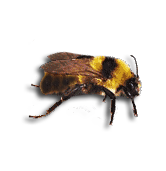General Characteristics:
- Large-bodied bee with a ‘fat and furry’ appearance
- About 250 species of bumblebees and about two dozen species in Canada
- Queen: body length 17-21 mm, male: body length 12-17 mm, worker: body length 8.5-16 mm
- Stocky with no discernable waist
- Very hairy body (pale yellowish hairs) and primarily black thorax
- Pollen baskets present on legs
- Females have smooth stingers and are capable of stinging many times
- Male, called drones, have no stinger at all
- Geographical range extends from eastern North America, Ontario to Maine and south to Florida
- Feeds on the pollen/nectar of a variety of flowers, but only creates enough honey to sustain the colony in times of food shortage
Reproduction:
- Social insects that primarily nest underground or under stones, logs, piles of leaves, old rodent burrows, etc…
- Four life stages over one year lifespan (egg, larva and pupa take up most of life and adult phase may only last a few weeks)
- Queen is the only on that survives through the winter
- Spring - Queen chooses nesting location and lays eggs
- Summer - Hive is built to capacity and pollen collection becomes priority
- Fall - Queen searches for hibernation location
- Winter - Queen hibernates until spring
Signs of Infestation:
- Nesting bumble bees become problematic when located near human areas
- Bees may be observed entering and exiting ground nests
- As females have smooth stingers and may repeatedly sting, this species can be very aggressive
- High volume of bumble bee activity may indicate a nearby nest
- Typical underground nests will be 15-23 cm in diameter with a 30 cm tunnel
Control Techniques:
- Reducing flowers will limit food availability and hinder nesting
- Reducing ground litter will eliminate potential harbourage areas
- Insecticides such as dusts, wettable powders, microencapsulated products, or aerosols may be used ACCORDING TO LABEL SPECIFICATIONS AND IN ACCORDANCE WITH FEDERAL, PROVINCIAL AND MUNICIPAL LAWS
- This species contributes to the pollination of many flowering plants and is considered beneficial unless the potential for human harm exists
- As this species may be quite aggressive a professional should be contacted to treat nesting sites
Please click here to contact a Focus Pest Control professional to inquire about further treatments for this pest species.
References:
Ascher, John S., et.al.. Discover Life- Bombus impatiens Cresson, 1863 Common eastern bumble bee. (On-line). Accessed on Dec. 3, 2009 at http://stri.discoverlife.org/mp/20q?act=x_ant&name=Bombus+impatiens&path=Insecta
/Hymenoptera/Apoidea/Apidae/Bombus/impatiens&authority=Cresson,+1863&common_name=Common+eastern
+bumble+bee&xml=Apoidea_species;Bombus;Bumblebees;&btxt=Discover+Life&burl=http://stri.discoverlife.org
Benett, Gary W., et.al.. Truman’s Scientific Guide to Pest Control Operations. Duluth: Advanstar Communications, 1988. p. 203-204.
“Insect Fact Sheets: Bumble Bees”(On-line). Hinterland Who’s Who. Accessed on Dec. 3, 2009 at http://www.hww.ca/hww2.asp?id=411.
“Pollinator Profile: Bumblebee”(On-line). Pollination Canada. Accessed on Dec. 3, 2009 at http://www.pollinationcanada.ca/
index.php?k=99.
“Species Bombus impatiens - Common Eastern Bumble Bee” (On-line). Iowa State University Entomology. Accessed on May 15, 2009 at http://bugguide.net/node/view/56797.
Disclaimer:
The Focus Pest Control ‘Pest Library’ is an educational resource written largely to educate the general public about common pests in Ontario. The Focus ‘Pest Library’ does not include all species in Ontario, nor does it include the most recent scientific data about species we describe. Though we edit our accounts for accuracy, we cannot guarantee all information in those accounts. While Focus Pest Control staff and contributors provide references to books and websites that we believe are reputable, we cannot necessarily endorse the contents of references beyond our control.
(Back to top)
|


